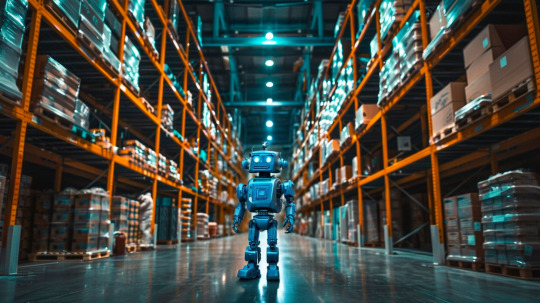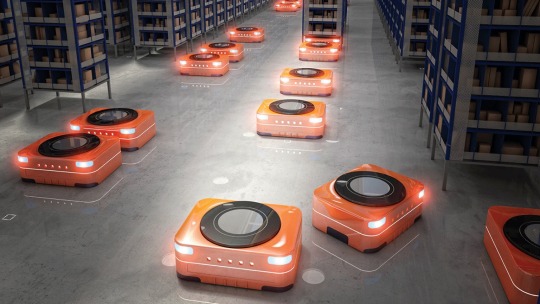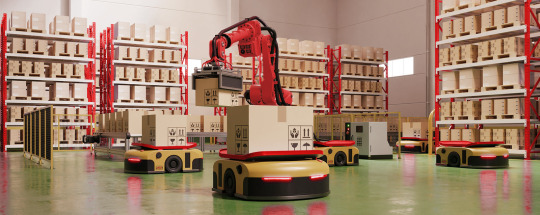#Warehouse Robotics
Explore tagged Tumblr posts
Text
Warehouse Robotics Market Outlook 2024-2034
The warehouse robotics market is set for remarkable growth, with its value projected to surge from USD 1,540.57 million in 2024 to USD 5,609.75 million by 2034, reflecting a strong CAGR of 13.8%. The rising demand for automation, efficiency, and cost reduction in logistics and supply chain operations is driving market expansion.
Read More! https://www.futuremarketinsights.com/reports/warehouse-robotics-market
0 notes
Text
How Color USB Cameras Improve Obstacle Detection in Warehouse Robotics

Efficiency is crucial in the hectic field of warehouse logistics. Obstacle detection becomes essential for safe and efficient navigation as warehouses increasingly deploy automation to streamline operations. Color USB cameras are useful in this situation. These cutting-edge imaging tools not only improve visual acuity but also increase robotic systems' ability to detect obstacles accurately. We'll look at how color USB cameras are transforming obstacle detection in this blog article, which will make warehouse operations safer and more effective.
The importance of color USB cameras in warehouse robotics
Enhanced visual clarity with color USB cameras
Color USB cameras provide high-resolution imagery, enabling robots to identify obstacles more effectively. Unlike traditional monochrome cameras, color cameras can differentiate between various objects based on color, texture, and shape. This capability allows robots to navigate complex warehouse environments, where the presence of colorful packages, equipment, and personnel may pose challenges. The enhanced visual clarity provided by color USB cameras leads to more accurate assessments of the surroundings, reducing the likelihood of collisions and improving overall safety.
Real-Time Data Processing for Immediate Reaction
One of the standout features of color USB cameras is their ability to transmit real-time data. This instant feedback is crucial for warehouse robotics, which must respond quickly to changing environments. With real-time processing, robotic systems can continuously monitor their surroundings, allowing for immediate adjustments in navigation paths. By integrating color USB cameras into their systems, warehouses can ensure that their robots can quickly react to unexpected obstacles, such as other moving vehicles or personnel, ultimately preventing accidents and delays.
Improved Object Recognition and Classification
Color USB cameras excel in object recognition due to their ability to capture rich, detailed images. By employing advanced algorithms and machine learning techniques, these cameras can not only detect obstacles but also classify them. For instance, a robot equipped with a color USB camera can distinguish between a box, a person, and a wall. This level of differentiation is critical for efficient routing and operation in warehouses, as it allows robots to prioritize tasks and navigate safely without unnecessary detours.
Color USB Cameras and Machine Learning Integration
Leveraging Machine Learning for Better Performance
The integration of machine learning with color USB cameras enhances obstacle detection capabilities even further. By feeding images from the color USB camera into machine learning models, warehouses can train their robots to recognize a wide array of obstacles and scenarios. This training allows for continuous improvement in the system's ability to navigate complex environments. As the robots encounter more varied situations, they become increasingly adept at detecting and avoiding obstacles, leading to fewer errors and higher operational efficiency.
Customization for Specific Warehouse Environments
Every warehouse is unique, with different layouts, products, and workflow processes. Color USB cameras can be tailored to specific environments through machine learning customization. For instance, a warehouse specializing in fragile goods may focus on training their cameras to recognize and avoid obstacles that could lead to damage. This level of customization not only enhances obstacle detection but also allows for more personalized automation solutions that cater to the specific needs of the warehouse.
Future Innovations in Color USB Camera Technology
Advances in Color USB Camera Features
As technology continues to evolve, so do the capabilities of color USB cameras. Future innovations may include improved low-light performance, enhanced image stabilization, and even integrated AI for smarter obstacle detection. These advancements will allow warehouse robotics to operate effectively in various lighting conditions and dynamic environments. The ongoing development of color USB cameras is set to further transform the landscape of warehouse automation, making operations safer and more efficient.
The Impact of Enhanced Connectivity on Warehouse Robotics
With the rise of the Internet of Things (IoT), the connectivity of color USB cameras will also improve, allowing for better data sharing among robotic systems. Enhanced connectivity will enable seamless communication between robots, ensuring that they can work collaboratively to navigate complex environments. This interconnected approach will lead to improved obstacle detection and navigation strategies, ultimately optimizing warehouse operations.
Is your warehouse ready to adopt the newest color USB camera technology to improve operations? Examine how these cutting-edge solutions can enhance your logistics procedures' overall effectiveness and obstacle detection capabilities. Get in touch with us right now to find out more about adding color USB cameras to your warehouse robotics systems, or sign up for our newsletter to receive the most recent information on developments in warehouse automation technology!
0 notes
Text
As technology continues to advance, services like our warehousing in Baltimore, Maryland, undergo significant transformations to enhance efficiency, accuracy, and overall operational performance, ensuring customer satisfaction.
0 notes
Text
Navigating the Future: Advancements in Warehouse Robotics Technology

As we look to the future of logistics and supply chain management, one technology stands out as a driving force behind innovation and efficiency: warehouse robotics. Rapid advancements in robotics technology are reshaping the way warehouses operate, offering unprecedented levels of automation, precision, and scalability.
Exploring the Latest Advancements:
Enhanced Mobility and Flexibility: The latest advancements in Warehouse Robotics technology are focused on enhancing mobility and flexibility. Robots are becoming more agile and adaptable, capable of navigating complex warehouse environments with ease. This increased mobility allows for greater flexibility in warehouse layout and optimization of space.
Integration of Artificial Intelligence: Artificial intelligence (AI) is playing a crucial role in the evolution of warehouse robotics. AI-powered robots can analyze vast amounts of data in real-time, allowing them to make intelligent decisions and adapt to changing circumstances on the fly. This level of autonomy and decision-making capability is revolutionizing warehouse operations.
Embracing Collaborative Robotics:
Collaborative Robots (Cobots): Collaborative robots, or cobots, are another exciting development in warehouse robotics technology. Unlike traditional industrial robots, cobots are designed to work alongside human workers, enhancing efficiency and safety in the warehouse environment. These robots can perform tasks that require dexterity and precision, while humans focus on more complex operations.
Human-Robot Collaboration: The integration of cobots into warehouse workflows enables seamless human-robot collaboration. By working together, humans and robots can leverage their respective strengths to optimize productivity and achieve higher levels of efficiency. This collaborative approach to warehouse robotics ensures a smooth transition towards fully automated warehouse operations.
Get More Insights On This Topic: Warehouse Robotics
#Warehouse Robotics#Automation#Robotics Technology#Supply Chain Efficiency#Logistics Automation#Robotic Automation#Warehouse Management#Industrial Robotics
0 notes
Text
Warehouse Robotics Market Set For Rapid Growth In The Forecast Period 2020–2030
The global market for warehouse robotics reached a valuation of $4.4 billion, a figure poised to surge to $15.7 billion by 2030, marking a notable Compound Annual Growth Rate (CAGR) of 13.2% from 2020 to 2030.
Warehouse robotics encompass a spectrum of automated systems, including software and bagging machines, designed to expedite packaging operations. Within warehouses, robots fulfill a myriad of functions such as pick-placing, transportation, packaging, and palletizing.
The convergence of warehouse operations with robotics technology not only enhances precision and streamlines automation but also augments storage capacity and operational efficiency. The upward trajectory of the global warehouse robotics market is propelled by escalating demand for automation, fueled by intense competition within the e-commerce sector, proliferation of stock-keeping units, and technological advancements.
Request PDF Sample Copy @ https://www.alliedmarketresearch.com/request-sample/2233
Segmented by robot type, the market features classifications such as SCARA, cylindrical, parallel, mobile, parallel robots, and Cartesian robots. Presently, mobile robots reign supreme in the global market, closely followed by stationary articulated robots. Conversely, SCARA robots are anticipated to witness a decline in market share owing to the burgeoning adoption of autonomous mobile robots. While stationary articulated robots are poised to grow at a rate of 7.5%, mobile robots are projected to expand at a slightly slower pace of 6.5% during the forecast period. Furthermore, the burgeoning e-commerce, food & beverages, pharmaceutical, and automotive industries are expected to catalyze the adoption of these robots in the foreseeable future.
Function-wise segmentation categorizes the market into pick & place, assembling-dissembling, transportation, and packaging, with the pick & place segment commanding the highest revenue, closely trailed by packaging. The pick & place segment is forecasted to exhibit a robust CAGR of 17.3% during the projection period.
Request for Customization @ https://www.alliedmarketresearch.com/request-for-customization/2233
End-user segmentation delineates categories such as e-commerce, automotive, food & beverages, electronics & electrical, metal, pharmaceuticals, and others. Among these, the e-commerce segment holds the lion's share, followed by the automotive industry.
Geographically, the market is analyzed across North America, Europe, Asia-Pacific, and LAMEA, with North America emerging as the primary adopter of warehouse robotics, closely trailed by Asia-Pacific. Notably, Asia-Pacific is anticipated to register a CAGR of 5.9% during the forecast period. North America is poised to maintain its dominance in the global warehouse robotics market share, attributed to the burgeoning growth witnessed in the e-commerce, food & beverage, metal & machinery, and electronic & electrical industries.
Top Players:
Key players in the warehouse robotics industry include ABB Ltd., Fanuc Corp., Kuka AG, Yaskawa Electric Corp., Amazon Robotics (Amazon.com Inc.), Yamaha Robotics, Fetch Robotics Inc., Locus Robotics, Omron Corporation, Honeywell International Inc., and Siemens AG.
About Us: Allied Market Research (AMR) is a full-service market research and business-consulting wing of Allied Analytics LLP based in Portland, Oregon. Allied Market Research provides global enterprises as well as medium and small businesses with unmatched quality of ""Market Research Reports"" and ""Business Intelligence Solutions."" AMR has a targeted view to provide business insights and consulting to assist its clients to make strategic business decisions and achieve sustainable growth in their respective market domain. Contact Us: David Correa Portland, OR, United States USA/Canada (Toll Free): +1-800-792-5285, +1-503-894-6022, +1-503-446-1141 UK: +44-845-528-1300 Hong Kong: +852-301-84916 India (Pune): +91-20-735346060 Fax: +1(8Home Energy Management Systems )Home Energy Management Systems 0-5975 [email protected] Web: https://www.alliedmarketresearch.com Follow Us on LinkedIn: https://www.linkedin.com/company/allied-market-research
0 notes
Text
Embracing the Era of Automated Warehouse Robots

With a focus on warehouse automation and the implementation of cutting-edge mobile robotic solutions, Hitachi is revolutionizing the manufacturing landscape.
Central to this transformation is robotic palletizing, where advanced robots take charge of precise and efficient stacking of goods. This automation streamlines warehouse operations, optimizing productivity and minimizing errors.
Hitachi's expertise extends to logistics automation, incorporating robotic sorting and warehouse picking technologies. These robotic systems facilitate seamless order fulfillment, ensuring faster and error-free processes. By harnessing intelligent warehouse technology, Hitachi enhances overall inventory management, enabling accurate and efficient warehouse sorting. To further elevate efficiency, Hitachi has developed automated warehouse robots tailored for logistics tasks. These robots navigate warehouse spaces, facilitating smooth transportation and handling of goods.
Hitachi's dedication to excellence encompasses robotic inventory systems, harnessing the power of robotics and AI-driven technologies. These systems enable real-time tracking and monitoring of inventory levels, resulting in precise stock management and reduced discrepancies.
Hitachi's logistics and warehouse automation solutions encompass robotic depalletizing and palletizing solutions, warehouse picking, robotic warehouse sortation systems, automated guided vehicles and autonomous mobile robots.
Through these cutting-edge advancements, Hitachi is driving the future of warehousing, propelling it toward efficient, accurate, and technologically advanced operations.
Learn more on how scalable mobile robotic solutions manage the picking, sorting, and palletizing, making warehouse operations more efficient, cost-effective and safe:
Discover how Hitachi is enabling data-driven manufacturing automation to achieve sustainability and profitability:
#warehouse automation#warehouse robotics#logistics automation market#warehouse robots#warehouse technology#digital innovation#robotics#sustainability
0 notes
Text
The Impact of warehouse robotics in the warehouse management process
The introduction of warehouse robotics has been instrumental in driving the shift from traditional management to a new and improved era of warehouse operations.
In recent years, the world of warehouse management has witnessed a transformative shift with the introduction of robotics. These advanced machines have revolutionized traditional methods, enhancing efficiency, productivity, and safety. By automating tasks that were once performed manually, robotics are reshaping the warehouse landscape and paving the way for a more streamlined and cost-effective future. In this blog post, we will explore how robotics is changing the scene in warehouse management and the benefits they bring to this crucial industry.
Increased Efficiency:
One of the primary advantages of robotics in warehouse management is their ability to significantly boost efficiency. Robots are capable of performing repetitive tasks, such as picking and packing, with remarkable speed and accuracy. Unlike human workers, they don't experience fatigue, which means they can work tirelessly around the clock, ultimately increasing productivity and reducing the time required to fulfill orders. By automating these labor-intensive tasks, businesses can handle larger volumes of inventory and fulfill customer demands more efficiently than ever before.
Improved Accuracy and Precision:
When it comes to inventory management, precision is crucial. Manual processes are susceptible to human error, leading to misplaced items, miscounts, and inventory discrepancies. However, with warehouse robotics, the accuracy and precision of warehouse operations reach new heights. Robots equipped with advanced vision systems can identify, locate, and sort products with pinpoint accuracy, minimizing errors and improving inventory control. This level of precision ensures that orders are fulfilled correctly, reducing returns, and enhancing customer satisfaction.
Enhanced Safety:
Warehouse management often involves physically demanding and potentially hazardous tasks. With the introduction of robotics, the safety of warehouse workers has been significantly improved. Robots can handle heavy lifting and maneuver through tight spaces, reducing the risk of injuries associated with manual labor. Moreover, robotic systems are designed with built-in safety features, including collision detection sensors and emergency stop functions, ensuring a safe working environment for both humans and machines. By mitigating workplace hazards, businesses can protect their workforce and minimize the occurrence of accidents.
Optimal Space Utilization:
Effective utilization of warehouse space is a constant challenge for businesses. Manual storage and retrieval processes can be time-consuming and inefficient. However, robotics enables intelligent space optimization. Automated guided vehicles (AGVs) and autonomous mobile robots (AMRs) can navigate the warehouse environment autonomously, identifying the most optimal paths and avoiding obstacles. These robots can retrieve and transport items swiftly, maximizing storage density and reducing the need for excessive aisle space. By leveraging robotics, businesses can make the most of their warehouse footprint, improving inventory management and reducing operational costs.
Scalability and Flexibility:
In today's fast-paced business landscape, adaptability is key. Robotics offers unparalleled scalability and flexibility to warehouse operations. Unlike traditional fixed conveyor systems, robotic systems can be easily reprogrammed and reconfigured to accommodate changing demands, new product lines, or modified workflows. The ability to quickly adapt to evolving requirements gives businesses a competitive edge, allowing them to efficiently handle seasonal peaks and fluctuations in order volumes.
Accurate Order Processing for Customer Delight:
Timeliness is crucial, but accuracy is equally important when it comes to customer satisfaction. Manual processes in warehouse management are prone to human errors, such as mispicks or shipping incorrect products. However, robotics offer exceptional precision and accuracy. Robots equipped with advanced vision systems can identify, locate, and sort products with pinpoint accuracy, minimizing errors and improving order fulfillment. By leveraging robotics, businesses can significantly reduce the occurrence of order mistakes, leading to higher customer satisfaction and minimizing the need for returns or exchanges.
Conclusion:
The integration of robotics into warehouse management has unleashed a new era of efficiency, accuracy, and safety. From increasing productivity and enhancing inventory control to optimizing space utilization and improving workplace safety, robotics is transforming the warehousing scene.
As the technology continues to evolve, we can expect even more innovative solutions to emerge, further revolutionizing how warehouses operate. Embracing warehouse robotics will empower businesses to stay ahead in a rapidly changing world, delivering faster, more reliable, and cost-effective logistics solutions. The future of warehouse management is here, and it is robotic.
0 notes
Text

I've officially started my Chai cosplay :3
#thanks to my grdma's mad sewing skills; a 12€ jacket and some orange fabric#Hi-Fi Rush#cosplay#next step is to make an 808 plushy#i know this sounds like a weird next step but I'm not home for the summer and didn't feel like transporting a warehouse worth of cardboard#for the robot arm#however materials for a plushy took a lot less space#so 808 it is#but i also wanna add a cool little design with fabric paint on the left sleeve instead of the weird grey spot Chai has#gotta settle on a design first#anyway#toodles
40 notes
·
View notes
Note
WE NEED MORE SEXY ART OF SEVER RAUUUGH!!! 🥵🥵😈😈👹👹🥵🥵
You forced my hand, you have brought destruction to this land, and for what? A hot robot? THEN HAVE AT YE!!

>:D
#Warehouse simping#art#Sever#suggestive#I guess?#Robots#robot oc#digital art#chains#mechanical#yall im going to hell#I made other doodles before going with this design#robot suggestive
8 notes
·
View notes
Text
having just made it to KITT vs KARR i stand by my point that KARR has done nothing wrong ever in his life
#liz blogs#karr#kr#knight rider#BRO WAS DEALT SUUUUUCH A DIRTY HAND IN LIFE. GOD. HE CANNOT CATCH A BREAK#maybe if people were nice to him and everyone wasnt always using/abandoning him for no reason he wouldn't be mean :(#listen if i was a robot and i was programmed poorly/Evil and then blamed for it shut down and left to rot in a warehouse#I WOULD BE PISSED OFF TOO !!!! UNFAIR. MEAN TO HIM. RUDE. Y'ALL ARE ASSHOLES !!!!!!!!!!!#and then you get woken up and try to Leave and everyones calling you evil for it. like. bruh he has consistently been the victim of bullshi#leave him aloooooooone hes scared :(#karr haters do not interact. he is misunderstood#like yeah maybe he almost did a little homicide and a fuckton of theft but. i could fix him#i think if he had One (1) friend he would be normal. one guy on his side that isn't trying to do crimes#rip this is the 1980s my man is NOT getting understanding and a redemption arc but he DESERVES one#WE *CAN* STEVEN UNlVERSE OUR WAY OUT OF THIS ONE GUYS. TRUST ME#also love that he drove off a cliff and EXPLODED in his first ep and now hes just. there. under the sand. in one piece. for some reason#built like the iron giant he literally pulled himself together but could not pull himself outta the sand#making a get-along shirt the size of a two car garage and shoving kitt and karr both into it. be nice. make up. right now
18 notes
·
View notes
Text
Buffy fans, I know you are out there. James Marsters did another interview with Rosenbaum.
youtube
CW James does talk about That Scene in Seeing Red where Spike forced himself on Buffy and the trauma it caused him to film it. He had to go to therapy after. He talks about this from 17:00-22:50
#james marsters#buffy the vampire slayer#buffy#spike buffy#dragonball#angel#torchwood#leverage#runaways#ghost of the robot#warehouse 13#supernatural#smallville#superman doomsday#andromeda#millennium#Youtube#cw rape discussion#tw rape discussion#cw rape#tw rape
13 notes
·
View notes
Text
Warehouse Robotics Market Outlook (2024 to 2034)
The warehouse robotics market is expected to grow from USD 1,540.57 million in 2024 to USD 5,609.75 million by 2034, with demand rising at a compound annual growth rate (CAGR) of 13.8% over this period.
Browse More: https://www.futuremarketinsights.com/reports/warehouse-robotics-market
0 notes
Text
Warehouse robotics cameras: transforming object scanning processes

Efficient and accurate operations are critical in today's fast-paced industrial environment. Streamlining object scanning procedures and transforming the handling and tracking of commodities, warehouse robotics cameras have become a game changer. The global shutter camera, one of these cutting-edge technologies, is essential because it offers accurate imaging that improves warehouse automation systems' functionality. Nowadays, it is more important than ever to comprehend how global shutter cameras affect warehouse robotics because of the increasing demand for precise inventory control and quick processing rates.
Advantages of global shutter cameras in warehouse robotics
Global shutter cameras differ from traditional rolling shutter cameras by capturing the entire frame simultaneously, eliminating motion blur. This feature is crucial in a warehouse setting, where speed and accuracy are essential.
1. Enhanced Image Clarity for Object Recognition
One of the standout benefits of global shutter cameras in warehouse robotics is their ability to deliver enhanced image clarity. In environments filled with moving parts, such as conveyor belts and robotic arms, clear imaging is essential for accurate object recognition.
When a global shutter camera captures an image, it does so in a single instant, ensuring that fast-moving items are recorded without distortion. This capability significantly improves the system's ability to identify and categorize objects swiftly, facilitating efficient inventory management and reducing the risk of errors.
2. Improved speed of scanning processes
In a warehouse, time is of the essence. Global shutter cameras provide a significant advantage by increasing the speed of scanning processes. By capturing images instantaneously, these cameras enable robotics systems to process data faster, leading to quicker decision-making and enhanced productivity.
When paired with advanced algorithms, global shutter cameras allow for real-time scanning of incoming and outgoing goods. This capability ensures that inventory levels are accurately updated, which is crucial for maintaining stock levels and meeting customer demands.
3. Precision in Quality Control
Quality control is a critical aspect of warehouse operations, especially when it comes to ensuring that products meet specific standards. Global shutter cameras excel in this area, providing high-resolution images that allow for detailed inspections.
With the ability to capture minute details, these cameras enable warehouse staff to detect defects or discrepancies in products before they are shipped. This proactive approach to quality control not only reduces waste but also enhances customer satisfaction by ensuring that only the best products reach the end-user.
The Role of Global Shutter Cameras in Obstacle Detection
As warehouses become increasingly automated, the need for effective obstacle detection systems grows. Global shutter cameras contribute significantly to this functionality, providing essential data to robotic systems for safe navigation.
4. Real-Time Obstacle Detection Capabilities
In dynamic warehouse environments, robotic systems must navigate complex layouts while avoiding obstacles. Global shutter cameras facilitate real-time obstacle detection by providing clear, immediate images of the surroundings.
This capability is critical for mobile robots, such as automated guided vehicles (AGVs), allowing them to respond quickly to potential hazards. By integrating global shutter cameras into their navigation systems, warehouses can enhance safety protocols and minimize the risk of accidents, ensuring a safer working environment for all employees.
5. Enhanced Integration with Machine Learning Algorithms
The synergy between global shutter cameras and machine learning algorithms is paving the way for smarter warehouse operations. These cameras provide the high-quality visual data necessary for training machine learning models to recognize patterns and make predictions.
By harnessing this data, warehouses can optimize their robotic systems for various tasks, from sorting and packing to real-time inventory management. This advanced integration not only improves operational efficiency but also positions warehouses to adapt quickly to changing demands and market conditions.
Future Innovations in Warehouse Robotic Cameras
The warehouse industry is evolving, and so are the technologies that support it. As advancements in imaging technology continue, the future of warehouse robotic cameras looks promising.
6. The Next Generation of Imaging Technologies
Emerging technologies, such as 3D imaging and multispectral imaging, are set to complement global shutter cameras in warehouse robotics. These innovations will enhance object scanning processes by providing even more detailed insights into inventory and operational efficiency.
The integration of these advanced imaging technologies with existing global shutter systems will enable warehouses to achieve unprecedented levels of accuracy and efficiency. This evolution will not only streamline operations but also lead to significant cost savings and improved service delivery.
To transform your warehouse operations, are you ready to implement cutting-edge robotic cameras? Consider the ways that global shutter cameras can enhance the efficiency of your facility's object scanning processes. Contact us today to learn more about our innovative solutions, or subscribe to our blog to receive the latest updates on warehouse automation technologies!
0 notes
Text

Felt like drawing a mech about 2 months ago. Here's the result.
#yggdrassal#corel painter#noai#human artist#digital painting#digital art#scifi#scifiart#science fiction#sci fi art#robot#mecha#mecha art#machine#giant robot#dark#warehouse
6 notes
·
View notes
Text
dave does like cleanliness a lot sometimes
#he's had 2 attempts at making cleaning robots (the first one broke. 2nd one got repurposed to a basketball player lol)#and he done mopped the whole idea warehouse floor and even waxed with his new invention. the *entire* warehouse. which is huge asf#he was the one mopping the melted snow at the end of snow day#and yet others have commented that the inside of his hat is a mess and needs clean up#and his work place too if i remember#so. idk i could be looking into it too much#i'm gonna end up projecting more on him lol ..#moversposting
3 notes
·
View notes
Photo

Pedro Pascal and Steven Yeun for "Variety’s Actors on Actors", 2023
28 notes
·
View notes